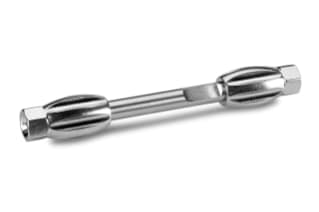
|
Chemistry |
Amide |
|
Separation Mode |
Hydrophilic Interaction (HILIC) |
|
Particle Substrate |
Hybrid |
|
pH Range Min |
2 pH |
|
pH Range Max |
11 pH |
|
Maximum Pressure |
6000 psi (415 Bar) |
|
Endcapped |
No |
|
Silanol Activity |
Low |
|
Particle Shape |
Spherical |
|
Particle Size |
3.5 µm |
|
Endfitting Type |
Waters |
|
Pore Size |
130 Å |
|
Format |
Column |
|
Surface Area |
185 |
|
System |
HPLC |
|
Particle Technology |
BEH |
|
USP Classification |
L68 |
|
Inner Diameter |
1 mm |
|
Length |
50 mm |
|
Carbon Load |
12 % |
|
UNSPSC |
41115709 |
|
Brand |
XBridge |
|
Product Type |
Columns |
|
Units per Package |
1 pk |
XBridge BEH Amide Column, 130Å, 3.5 µm, 1 mm X 50 mm, 1/pk
Extremely polar molecules, such as sugars and carbohydrates, are retained by XBridge BEH Amide columns. To enable the separation of polar analytes spanning a wide range of polarity, structural moiety, and pKa, XBridge Amide columns provide you with a chemically stable, tri-functionally linked amide phase that is stable from pH 2-11.
The XBridge BEH Amide Column uses a chemically stable, tri-functionally bound amide phase to offer superior stability and adaptability in HILIC separations laboratory equipment. It is based on Waters' novel ethylene bridged hybrid (BEH) particle. In order to preserve and separate extremely polar compounds in HILIC stationary phases, Waters developed this capacity. Scientists may simply transfer separations between HPLC and UPLC technology platforms since the XBridge BEH Amide Column has the same selectivity as ACQUITY UPLC BEH Amide columns.
Since the lab equipment was designed specifically to retain polar analytes and metabolites that are too polar to retain using reversed-phase chromatography, it can readily tolerate the usage of a wide range of mobile phase pH. This item is ideal for the analysis of carbohydrates because it has a particle size of 3.5 µm and a pore size of 130. The XBridge BEH Amide Column allows for high resolution and quick analysis in challenging sample matrices while maintaining or enhancing chromatographic resolution.
All our lab equipment is manufactured under the strictest conditions and undergoes high standards of quality assurance so that you only receive top-quality products from your lab. We offer a variety of brands and versions that are specifically developed to fulfill the needs of every sort of chromatographic analysis.
If you would like to see more lab equipment from Waters, you can look through our catalog or visit our website, where you can shop for lab equipment to meet all of your laboratory needs. You may want to review the XBridge BEH Amide VanGuard Cartridge, 130Å, 5 µm, 2.1 mm X 5 mm, 3/pk; XBridge BEH Amide VanGuard Cartridges are used to extend analytical column lifetime and performance by removing particulate contamination from the mobile phase stream. This cartridge is optimized to protect all 2.1 mm and 3.0 mm I.D. XBridge BEH Amide analytical columns containing 5 µm sorbent particles.
What Function Does BEH Play in Chromatography?
The BEH (Ethylene Bridged Hybrid) particle, which is available in a range of pore sizes and bonded phases and supports both reversed-phase and hydrophilic contact chromatography, is one of the key components underlying UPLC technology. The method can be used to assess both small and large molecules in biopharmaceutical products.